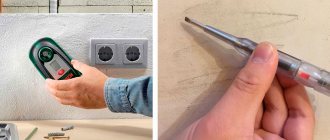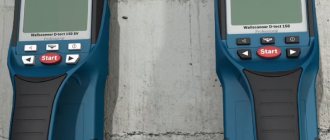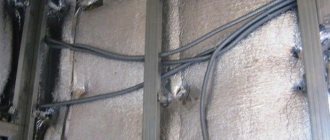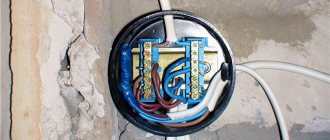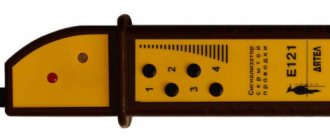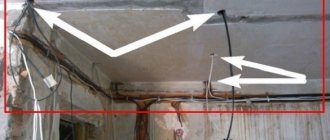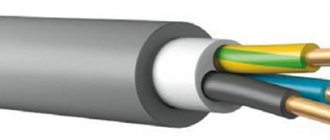People who, due to their profession or at some point in their lives, are constantly forced to deal with major renovations of premises, are often faced with the need to carry out certain work on the installation of new communications without damaging existing ones.
For example, you need to drill many holes without damaging the wiring, or simply hammer a nail or pierce the walls without touching the reinforcement, etc. To solve these problems, you have to either invite specialists with professional instruments, or purchase these instruments yourself, which cost significant amounts.
For example, the price of a professional multi-detector Hilti PS 38 in some online stores exceeds 70,000 rubles.
The Vayyar company, using its scanner and smartphone application called Walabot DIY, offers to solve this problem at a relatively low cost.
Thanks to this scanner, you can easily use an ordinary smartphone to find not only wiring behind the wall, but also any communications lying at a depth of up to 10 cm (plastic and metal pipes, profiles, wooden beams, fittings and much more).
Having looked at the videos, you might think that this is all some kind of advertising gimmick, but the device really works. The company simply applied technologies that were previously used in medicine in another field of activity, and did it in a competent way.
Walabot DIY doesn't just make a sound or light up a light to indicate that there is wiring behind the plaster. You can visually find and see the location of wires, pipes, fittings and other communications on the screen of your smartphone in real time.
6 ways to find hidden wiring under plaster
There are several ways to find hidden wiring in a wall. One of them is using an indicator screwdriver. Read about the rest in the article. We will also dispel myths regarding some so-called “folk” methods.
Remodeling an apartment, installing additional sockets, moving a doorway - all this requires knowledge of the location of the old wiring, which is “walled up” in the wall. There are several ways to figure out where the wiring is. Some of them are less accurate, but they are cheap, others will determine the location of the wire with an accuracy of a centimeter, but you will have to fork out for them. Let's discuss effective methods and dispel myths about some.
Metal detectors
These are compact metal detectors that do an excellent job of finding everything that is hidden from view. After all, a device of this type can accurately search for wiring in the wall. It will even find those electrical lines that are de-energized.
The metal detector coil creates an electromagnetic field around itself
Some models of such devices can even determine the type of metal, indicate voids in the surface structure, and find wood and plastic. A device for detecting hidden wiring of this type is based on a coil. It creates an electromagnetic field around itself, which helps to find the necessary objects.
The products of Tesla, which specializes in the production of electrical equipment, have proven themselves best.
Radio search
If you haven't thrown out your old radio yet, but keep it as a rarity, then you can use it to find wiring hidden in the wall. To do this you will need to set it to 100 kHz. It is also necessary that there is voltage in the network. Then pull the antenna to the maximum and lean it against the wall (you can do without an antenna). Slowly move the antenna along the wall (without touching, so as not to create friction) - the closer you are to the wiring, the more you will hear a characteristic crackling sound. Try to remain quiet so you can clearly hear the change in tone.
The radio allows you to find the wire with an accuracy of 10 cm - this is of course a large error, but if you just need to figure out where to hammer a nail for a picture, then this method is suitable. We do not recommend using this method to “open” the wall.
How to locate a person by phone
If you need to find out where your child, spouse is currently located, use these instructions below.
To determine the location of a person over the phone, this person must have a smartphone with an Internet connection and a Google account. And it is desirable that the smart device be equipped with a GPS module for more accurate determination of position coordinates. First, you need to make some settings on your smartphone; to do this, go to settings. Select the “Location Data” tab
A window like this will open. In the “Access to my geodata” and “By network coordinates” checkboxes. And set the position to ON for GPS satellites. By the way, this function greatly drains the battery and if you only need to know the approximate location of, for example, your child, then GPS can be turned off. This way you will increase the battery life of your smartphone. But the error in determining the position will be within a radius of 1 to 4 kilometers.
Looking for our phone
And so, in order to determine by phone where your child is at the moment, go from a computer, tablet or phone to your Google account at this address https://myaccount.google.com, to which the smartphone you are going to monitor is connected. Enter your username and password and select the Find Phone menu.
Next, select our smartphone on which we enabled geolocation.
And click find phone.
A map will open in front of us indicating the location of our phone, circled in blue. In our case, the GPS module was disabled, so the error was 3 km 400 meters. If you turn it on, the accuracy of the determination will be within a radius of one to three meters.
If you click on “Ring the phone” it will make a sound at full volume, which can be turned off by pressing the power button on your mobile phone.
You can put all this into practice anywhere. If you hide your smartphone in a car, then in case of theft, you can easily determine where your vehicle is currently located. Of course, it will have to be constantly recharged or connected to the car’s on-board power supply. And of course, the main condition should be to connect your mobile phone to the Internet.
Looking for hearing aid wiring
Old-style hearing aids will allow you to determine the location of the wiring with “average” accuracy. Some hearing aids, such as the AK-1 model, have a “phone” mode that allows hearing-impaired people to talk on the phone without extraneous noise. In this mode, the device will be sensitive to fluctuations in electromagnetic waves. Now you just need to follow the wall in the place where you think the wire should lie. As soon as you hear a characteristic crackling sound, you have stumbled upon a wire. Its error is approximately the same as that of a radio receiver.
Flaws
In addition to all the advantages described, there are also some disadvantages. For example, while working with the device, the phone gets very hot and quickly consumes battery power.
This is due to the fact that Walabot does not have its own power supply and, like a parasite, consumes energy from a smartphone.
The protective film that is used to crawl on the wall is very impractical and quickly lifts up in the corners.
However, craftsmen can try to adapt a protective glass for the phone screen instead.
Another problem arises with the Velcro for connecting the smartphone and walabot. It comes off so hard that it can open the cover of the phone itself.
On walls with reinforcement, the scanner equally detects whether there is a wire or a steel mesh inside the concrete. Therefore, there may be errors in the accuracy of the electrical wiring.
If you have a brick wall, then you can only work normally in the “expert” mode with red spots on the screen.
Indicator screwdriver to help
This is the most effective of the “cheap” methods. The price is 100 - 150 rubles, but with its help you can determine the wire under the plaster with good accuracy. So, to identify the wire, you need to pinch the slot (tip) with your fingers, and move the back side over the location of the intended wire. When detected, the LED will light up red (or some other color). Please note that a screwdriver can detect a wire at a depth of no more than 2 cm, and it must be live. Therefore, if the wiring lies deeper, the screwdriver is unlikely to notice it.
In any case, every electrician should have an indicator screwdriver in his arsenal. Here, for example, is an inexpensive version of the ROBITON VT-005 indicator screwdriver, which allows you to determine voltage by contact and non-contact methods.
Metal detector
The operation of the metal detector is based on the principle of induction balance between the transmitting and receiving coils. It operates in the range from 2 to 20 kHz, and records the phase shift when the coil is brought to the conductor. We carried out measurements using the cheapest and simplest metal detector, Pirat Pro, costing 2,500 rubles, which is mainly designed to detect ferrous metal. The illustration below shows the result of a wiring search.
As you can see, the metal detector clearly determines the location of the wiring. Its main advantage is that the wire is detected even if there is no voltage or load on it. Also, in panel houses you will see reinforcement in slabs, and in wooden houses - nails. But more expensive models allow you to cut out ferrous metals and find only copper or aluminum. However, the location area is increased by the size of the coil, so the error can be up to 5 cm. This method should only be used if you like to hunt for coins and you already have a metal detector.
Search with a multimeter
To search for wiring with a multimeter, you will need the device itself and a regular transistor, for example, 2SK241. We set the resistance measurement on the device to 200 kOhm, and place both crocodiles on the left and middle terminals of the transistor. The rightmost pin, which is left without a crocodile, will be the antenna. For additional measurement accuracy, you can connect a 5 cm long copper wire to the rightmost terminal.
Now it is enough to drive a transistor with an improvised antenna along the wall. When the transistor enters an electromagnetic field, its resistance will change, which will be displayed on the multimeter. This method is more accurate than all others, but also produces an error of up to 7 cm in each direction (the indicator depends on the depth of the wire). By the way, you can use any multimeter, even the most inexpensive one, such as Elitech MM 100.
Small metal detector
The detector is designed to search for hidden wiring, fittings and other metal objects.
The main difference from previous models is that you do not need to wind the inductors yourself. Instead, a relay coil is used. The work of the finder is based on the task of isolating the difference frequency of two generators, when, when approaching a metal object, one search generator (LC) changes its oscillation frequency.
The metal detector includes LC and RC generators, a buffer stage, a mixer, a comparator and an output stage.
The frequencies of the RC and LC generators are selected to be approximately the same, then, after passing through the mixer, the output will already have three frequencies. The third is equal to the difference between the frequencies of the RC and LC circuits.
The low-pass filter subtracts the difference frequency and sends the signal to the comparator, where a square wave of the same frequency is formed.
From the output element, the meander goes through capacitance C5 to the telephone, whose resistance should be approximately 0.1 KOhm. Since the capacitance and active resistance of the telephone form a differentiating RC circuit, an impulse will be formed during the rise and fall of the meander. As a result, a person will hear clicks with a frequency twice the difference.
Detection of hidden wiring will be detected by a change in sound frequency. The coil is taken from the RES 9 relay, and the moving elements are removed. Since the relay contains 2 coils with different cores, the common terminals of the windings must be connected to capacitance C1, and the core and variable resistance housing must be connected to a common bus.
Double-sided foil getinax or fiberglass is used as a printed circuit board. The finder parts should be placed on one side; the other side does not need to be etched, it must be connected to the common bus of the device.
A battery and an inductor from a relay are attached to the second side.
The board is installed in any non-metallic case where the phone connector is attached. Setting up a metal detector begins with adjusting the frequency of the LC generator by selecting capacitance C1. The frequency should be in the range of 60-90 kHz.
Then we change the capacitance of capacitor C2 until sound appears in the phone. When adjusting the resistance in different directions, the sound should change.
Depending on the setting, the frequency will change and the detector will make a sound as if searching for a radio station. The closer the metal, the louder the sound. The tonality depends on the type of metal.
Hidden wiring detector
This device is directly designed to detect hidden wiring in the wall. Based on their operating principle, detectors can be electrostatic, electromagnetic or combined. The first ones are quite easy to use and inexpensive. They allow you to detect hidden wiring and broken wires that remain live. However, at high indoor humidity they give false alarms.
Electromagnetic detectors allow you to very accurately identify cables in the wall. However, to do this, you need to apply a load to the phase of at least 1 kW - for modern household appliances this will not be difficult. Naturally, without voltage in the network, it will not be possible to find the cable.
Combined devices combine electromagnetic, electrostatic and metal detecting. Essentially, this is a hand-held metal detector that allows you to find a wire in different ways, even in the absence of voltage in the network. The maximum detection depth for most devices is 7 - 8 cm, which is quite enough for wiring in an apartment. Additionally, he can see reinforcement in walls and other metals. The ADA instruments Wall Scanner 80 detector is a prominent example of wiring “sleuths”, allowing you to identify cables at a depth of up to 5 cm.
Comparative analysis of prices for household and professional devices
For ease of understanding, the data for comparison is presented in table form:
| No. | Device name | Model | Manufacturer country | price, rub. |
| 1. | SafeLife MS-18 | Indicator screwdriver | China | 500 |
| 2. | E-121 Woodpecker | Hidden wiring alarm | Russia | 1800 |
| 3. | Bosch GMS-120 | Wiring detector | Malaysia | 5 500 |
Of course, the difference in price values may seem quite significant, but the purpose of the devices, their capabilities, accuracy of operation and working life are also different. If the indicator screwdriver is intended for periodic use in everyday life, then hidden wiring detectors are intended for professional use for work at various sites and have appropriate performance indicators.
Prices are given as information and represent the average value of the cost of goods in online stores, and therefore cannot be used for making estimates and links for placing orders.
“Folk” methods that don’t work
Search by compass
Some people mistakenly assume that if you hold a compass near the intended location with the cable, the magnetic needle will point to it. However, at home it is simply impossible to create magnetic induction of such strength that a compass will show the cable. At most, you can find out the location of the cardinal directions, or find the hidden treasures of Captain Flint :)
Search by smartphone
Some developers offer to turn your smartphone into a metal detector using their “miracle” applications. To do this, the phone just needs to have a magnetic sensor installed (we have one). iCHIP decided to take the plunge and check out popular metal detecting apps. We tested it in the same place as with a metal detector. Here's what happened:
As you can see, the readings of the “detector” in an empty space and in the place where the wiring actually passed through practically did not change, although the indicator should have become 0.02 - 0.03 mT. The same thing happened with other applications. From this we conclude that searching for wiring with a smartphone using applications is a rather dubious activity.
Perhaps you know other ways to detect wiring, or vice versa, that some methods are no longer relevant. Share them in the comments!
Source
Smart home via smartphone
You can often hear this phrase – smart home. Let's figure out what this means and how to organize everything in practice. We can definitely say that a smart home is an automated system that, without human intervention, controls the switching on and off of household appliances and lighting. That is, it turns on the light when it’s dark and turns it off when it’s dawn. Controls the operation of air conditioning and heating systems. It will shut off the water during leaks, and so on.
Ready-made smart home kit.
But it is much more interesting and convenient to implement a smart home through a smartphone. This way you can turn off and on the lights in any room via your smartphone, open the garage door, turn on the electric kettle without leaving the couch. Yes, in general, anything, as long as your imagination and finances are enough.
How it works? The heart of a smart home is a controller to which the necessary sensors and relays are connected, turning on and off the necessary electrical appliances and mechanisms. To control the controller via a smartphone, the controller and smartphone must be connected to the same WI-FI network. To do this, install a WI-FI adapter into the controller. A program is also written for it. And a special application is installed on the smartphone, with the help of which control takes place.
Assembling the components of a smart home is not difficult; even a novice radio amateur can do it. All the necessary components for this are commercially available. Everything comes together like a construction set. Sensors are connected to the controller (these can be humidity, temperature, motion, light, shock, video cameras), modules and actuators (relays, which in turn turn them on and off.)
The main difficulty is the implementation of connecting all electrical appliances to the actuator. This difficulty is associated with a large volume of electrical wiring installation, so it is advisable to design a smart home at the stage of construction or major renovation of a house or apartment. Of course, if you need to control one gate or street lighting, then organizing a smart home via a smartphone will not be difficult in principle.
How to find a wire in the wall
We must immediately make a reservation and say that there are special detectors to search for hidden wiring. They cost several thousand, and allow you to more or less accurately find out where exactly the hidden wiring runs.
The wire detector can detect a phase wire if electricity is passing through it. Also, some detector models react to metal inside the wall, under the thickness of the plaster. The thicker its layer, the more powerful the wiring detector should be.
However, purchasing such a miracle device is not always advisable and justified, especially for those who do not make repairs on an ongoing basis. In this case, you can try to find the wiring in the wall in other ways, without resorting to buying expensive devices.
Comparative analysis of prices for household and professional devices
For ease of understanding, the data for comparison is presented in table form:
| No. | Device name | Model | Manufacturer country | price, rub. |
| 1. | SafeLife MS-18 | Indicator screwdriver | China | 500 |
| 2. | E-121 Woodpecker | Hidden wiring alarm | Russia | 1800 |
| 3. | Bosch GMS-120 | Wiring detector | Malaysia | 5 500 |
Of course, the difference in price values may seem quite significant, but the purpose of the devices, their capabilities, accuracy of operation and working life are also different. If the indicator screwdriver is intended for periodic use in everyday life, then hidden wiring detectors are intended for professional use for work at various sites and have appropriate performance indicators.
Prices are given as information and represent the average value of the cost of goods in online stores, and therefore cannot be used for making estimates and links for placing orders.
Finding wiring in the wall using a multimeter
You can also find hidden wires in the wall using a digital multimeter. You will also need a transistor brand 2SK241, KP103A or KP303. In order for the multimeter to find wiring hidden in the wall, you need to connect a transistor to its probes - one probe to the left terminal of the transistor, and the second probe to the right.
Then you need to switch the multimeter to resistance measurement mode, after which you can start searching for electrical wiring in the wall. The principle of operation of the multimeter in the wire search mode is simple: the right terminal of the transistor is used as an antenna and when it enters a magnetic field from electricity, the transistor will change its resistance, which the multimeter will certainly let you know.
You can also use an indicator screwdriver to search for wires in the wall. However, the screwdriver must be “active”; a regular one, unfortunately, is not suitable. When checking, the screwdriver is turned over with the handle facing the wall and moved along the surface until the indicator lights up. As for a smartphone, to find wiring in the wall using it, you need a special sensor and appropriate software.
Source
Walabot DIY package
What's included in the package?
It's about the size of most modern smartphones, but only twice as thick. It is very similar to an external USB battery for phones. At the bottom there are micro USB connectors. Connection to a smartphone and computer occurs through them. After the first connection, you need to go through the application installation process. At the moment, only Android smartphones are supported.
For owners of iPhone of any model, this scanner is not yet available.
The application itself can be downloaded from Google Play.
- Privacy and Security: How to disable ssid to hide Wi-Fi network - 2021
There is also a visual video instruction on how to initially install the device on your phone and configure it.

